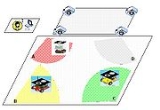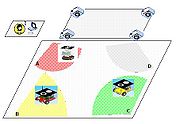
Networked control system
Encyclopedia
A Networked Control System (NCS) is a control system
wherein the control loops are closed through a real-time network
. The defining feature of an NCS is that control and feedback signals are exchanged among the system's components in the form of information packages through a network.
The most important feature of a NCS is that it connects cyberspace to physical space thus, enabling execution of several tasks from long distance. In addition, networked control systems eliminate unnecessary wiring thus, reducing the complexity and the overall cost in designing and implementing the control systems. They can also be easily modified or upgraded by adding sensors, actuators and controllers to them with relatively low cost and no major changes in their structure. Moreover, featuring efficient sharing of data between their controllers, NCS are able to easily fuse global information to make intelligent decisions over large physical spaces.
Their potential applications are numerous and cover a wide range of industries such as: space and terrestrial exploration, access in hazardous environments, factory automation, remote diagnostics and troubleshooting, experimental facilities, domestic robots, aircraft, automobiles, manufacturing plant monitoring, nursing homes and tele-operations.
 Advent and development of the Internet combined with the advantages provided by NCS attracted the interest of researchers around the globe. Along with the advantages, several challenges also emerged giving rise to many important research topics. New control strategies, kinematics of the actuators in the systems, reliability and security of communications, bandwidth allocation, development of data communication protocols, corresponding fault detection and fault tolerant control strategies, real-time information collection and efficient processing of sensors data are some of the relative topics studied in depth.
Advent and development of the Internet combined with the advantages provided by NCS attracted the interest of researchers around the globe. Along with the advantages, several challenges also emerged giving rise to many important research topics. New control strategies, kinematics of the actuators in the systems, reliability and security of communications, bandwidth allocation, development of data communication protocols, corresponding fault detection and fault tolerant control strategies, real-time information collection and efficient processing of sensors data are some of the relative topics studied in depth.
The insertion of the communication network in the feedback control loop makes the analysis and design of an NCS complex, since it imposes additional time delays in control loops or possibility of packages loss. Depending on the application, time-delays could impose severe degratation on the system performance.
To alleviate the time-delay effect, Y. Tipsuwan and M-Y. Chow, in ADAC Lab at North Carolina State University, proposed the Gain Scheduler Middleware (GSM) methodology and applied it in iSpace. S. Munir and W.J. Book (Georgia Institute of Technology) used a Smith predictor, a Kalman filter
and an energy regulator to perform teleoperation through the Internet.
K.C. Lee, S. Lee and H.H. Lee used a genetic algorithm to design a controller used in a NCS. Many other researchers provided solutions using concepts from several control areas such as robust control, optimal stochastic control
, fuzzy logic etc.
Moreover, a most critical and important issue surrounding the design of distributed NCSs with the successively increasing complexity is to meet the requirements on system reliability and dependability, while guaranteeing a high system performance over a wide operating range. This makes network based fault detection and diagnosis techniques, which are essential to monitor the system performance, receive more and more attention.
Control system
A control system is a device, or set of devices to manage, command, direct or regulate the behavior of other devices or system.There are two common classes of control systems, with many variations and combinations: logic or sequential controls, and feedback or linear controls...
wherein the control loops are closed through a real-time network
Computer network
A computer network, often simply referred to as a network, is a collection of hardware components and computers interconnected by communication channels that allow sharing of resources and information....
. The defining feature of an NCS is that control and feedback signals are exchanged among the system's components in the form of information packages through a network.
Overview
The functionality of a typical NCS is established by the use of four basic elements:- Sensors, to acquire information,
- ControllersController (control theory)In control theory, a controller is a device which monitors and affects the operational conditions of a given dynamical system. The operational conditions are typically referred to as output variables of the system which can be affected by adjusting certain input variables...
, to provide decision and commands, - Actuators, to perform the control commands and
- Communication network, to enable exchange of information.
The most important feature of a NCS is that it connects cyberspace to physical space thus, enabling execution of several tasks from long distance. In addition, networked control systems eliminate unnecessary wiring thus, reducing the complexity and the overall cost in designing and implementing the control systems. They can also be easily modified or upgraded by adding sensors, actuators and controllers to them with relatively low cost and no major changes in their structure. Moreover, featuring efficient sharing of data between their controllers, NCS are able to easily fuse global information to make intelligent decisions over large physical spaces.
Their potential applications are numerous and cover a wide range of industries such as: space and terrestrial exploration, access in hazardous environments, factory automation, remote diagnostics and troubleshooting, experimental facilities, domestic robots, aircraft, automobiles, manufacturing plant monitoring, nursing homes and tele-operations.
Types of communication networks
- FieldbusesFieldbusFieldbus is the name of a family of industrial computer network protocols used for real-time distributed control, now standardized as IEC 61158....
, e.g. CAN, LON etc. - EthernetEthernetEthernet is a family of computer networking technologies for local area networks commercially introduced in 1980. Standardized in IEEE 802.3, Ethernet has largely replaced competing wired LAN technologies....
- Wireless networks, e.g. BluetoothBluetoothBluetooth is a proprietary open wireless technology standard for exchanging data over short distances from fixed and mobile devices, creating personal area networks with high levels of security...
or ZigBeeZigBeeZigBee is a specification for a suite of high level communication protocols using small, low-power digital radios based on an IEEE 802 standard for personal area networks. Applications include wireless light switches, electrical meters with in-home-displays, and other consumer and industrial...
. The term Wireless Networked Control System (WNCS) is often used in this connection.
Problems and solutions

The insertion of the communication network in the feedback control loop makes the analysis and design of an NCS complex, since it imposes additional time delays in control loops or possibility of packages loss. Depending on the application, time-delays could impose severe degratation on the system performance.
To alleviate the time-delay effect, Y. Tipsuwan and M-Y. Chow, in ADAC Lab at North Carolina State University, proposed the Gain Scheduler Middleware (GSM) methodology and applied it in iSpace. S. Munir and W.J. Book (Georgia Institute of Technology) used a Smith predictor, a Kalman filter
Kalman filter
In statistics, the Kalman filter is a mathematical method named after Rudolf E. Kálmán. Its purpose is to use measurements observed over time, containing noise and other inaccuracies, and produce values that tend to be closer to the true values of the measurements and their associated calculated...
and an energy regulator to perform teleoperation through the Internet.
K.C. Lee, S. Lee and H.H. Lee used a genetic algorithm to design a controller used in a NCS. Many other researchers provided solutions using concepts from several control areas such as robust control, optimal stochastic control
Stochastic control
Stochastic control is a subfield of control theory which deals with the existence of uncertainty in the data. The designer assumes, in a Bayesian probability-driven fashion, that a random noise with known probability distribution affects the state evolution and the observation of the controllers...
, fuzzy logic etc.
Moreover, a most critical and important issue surrounding the design of distributed NCSs with the successively increasing complexity is to meet the requirements on system reliability and dependability, while guaranteeing a high system performance over a wide operating range. This makes network based fault detection and diagnosis techniques, which are essential to monitor the system performance, receive more and more attention.
Further reading
- D. Hristu-Varsakelis and W. S. Levine (Ed.): Handbook of Networked and Embedded Control Systems, 2005. ISBN 0-8176-3239-5.
- S. Tatikonda, Control under communication constraints, MIT Ph.D dissertation, 2000. http://dspace.mit.edu/bitstream/1721.1/16755/1/48245028.pdf
- O. Imer, Optimal estimation and control under communication network constraints, UIUC Ph.D. dissertation, 2005. http://decision.csl.uiuc.edu/~imer/phdsmallfont.pdf
- Y. Q. Wang, H. Ye and G. Z. Wang. Fault detection of NCS based on eigendecomposition, adaptive evaluation and adaptive threshold. International Journal of Control, vol. 80, no. 12, pp. 1903-1911, 2007.
- M. Mesbahi and M. Egerstedt. Graph Theoretic Methods in Multiagent Networks, Princeton University Press, 2010. ISBN: 978-1-4008-3535-5. https://sites.google.com/site/mesbahiegerstedt/home
External links
- Networked Control Systems Repository (NCSR)
- Networked Control Systems Laboratory
- Networked Control Systems and Internet Robotics
- Advanced Diagnosis Automation and Control Lab (NCSU)
- Co-design Framework to Integrate Communication, Control, Computation and Energy Management in Networked Control Systems (FeedNetback Project)

